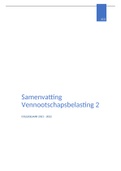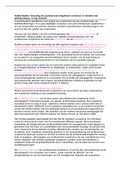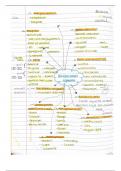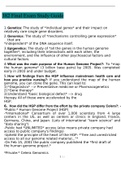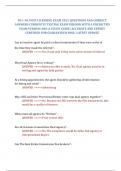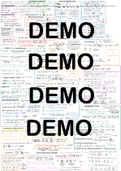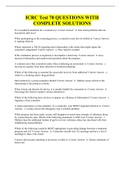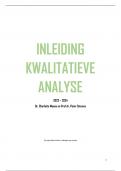ds
SAMENVATTING MACRO-ECONOMIE
2020 - 2021
KU Leuven campus Brussel
,Inhoudsopgave
Lijst met figuren ................................................................................................................. 5
Onderscheid micro- en macro-economie ............................................................................ 7
20 Measuring a Nation’s Well-Being and the price level .................................................. 8
20.1 The Nature of Macroeconomics ...................................................................................... 8
20.2 The Economy’s Income and Expenditure ......................................................................... 9
20.3 The Measurement of Gross Domestic Product (= GDP) .................................................. 10
20.4 The Components of GDP ............................................................................................... 10
20.5 Real Versus Nominal GDP ............................................................................................. 11
20.5.1 Waarom de totale uitgaven van jaar tot jaar kunnen stijgen ..................................... 11
20.5.2 Real versus Nominal GDP ............................................................................................ 11
20.5.3 The GDP Deflator ........................................................................................................ 11
20.6 The Limitations of GDP As A Measure of Economic Well-being ...................................... 12
20.7 International Differences in GDP and the Quality of Life ............................................... 13
20.8 Measuring the Cost of Living ......................................................................................... 13
20.9 The Consumer Price Index (CPI) ..................................................................................... 14
20.9.1 How the Consumer Price Index Is Calculated.............................................................. 14
20.9.2 The Producer Price Index (PPI) .................................................................................... 14
20.9.3 Problems in Measuring the Cost of Living ................................................................... 15
20.9.4 The GDP Deflator versus the Consumer Price Index ................................................... 15
20.10 Correcting Economic Variables for the Effects of Inflation ......................................... 16
20.10.1 Real and Nominal Interest Rates ................................................................................. 16
20.10.2 Illustration: Real and Nominal Interest Rates ............................................................. 16
20.11 Synthese ................................................................................................................... 17
21 Production and Growth ............................................................................................ 18
21.1 Economic growth around the world .............................................................................. 18
21.2 Growth theory .............................................................................................................. 19
21.2.1 Factors influencing growth ......................................................................................... 19
21.3 Productivity .................................................................................................................. 20
21.3.1 Why productivity is so important................................................................................ 20
21.3.2 How productivity is determined ................................................................................. 20
21.4 The determinates of Economic Growth ......................................................................... 22
21.4.1 Aggregate Production Function .................................................................................. 22
21.4.2 Assumptions in Solow Theory ..................................................................................... 22
21.4.3 Output and capital per worker.................................................................................... 23
21.4.4 Decreasing returns to capital ...................................................................................... 24
21.4.5 Long-run Equilibrium................................................................................................... 24
21.4.6 Solow model................................................................................................................ 27
21.5 Causes of Growth .......................................................................................................... 28
21.5.1 Changes in the saving rate .......................................................................................... 28
21.5.2 An increase in the population ..................................................................................... 30
21.5.3 Dilution of Capital Stock .............................................................................................. 30
21.5.4 Promoting Technological Progress .............................................................................. 30
21.5.5 An Increase in Technology .......................................................................................... 31
21.6 Endogenous Growth Theory .......................................................................................... 31
21.6.1 Long-run Growth Is Generated by Changes In Technology ......................................... 31
21.7 Economic growth and public policy ............................................................................... 33
21.7.1 The Importance of Saving and Investment ................................................................. 33
21.7.2 Diminishing Returns and the Catch-Up Effect ............................................................. 33
21.7.3 Open Economy ............................................................................................................ 35
2
, 21.7.4 Investment in the Country by Foreigners ................................................................... 35
21.7.5 Education .................................................................................................................... 35
21.7.6 Health and Nutrition ................................................................................................... 35
21.7.7 Property Rights and Political Stability ......................................................................... 36
21.7.8 Free Trade ................................................................................................................... 37
21.7.9 Research and Development ........................................................................................ 37
21.7.10 Population Growth ...................................................................................................... 37
21.8 Conclusion .................................................................................................................... 38
21.8.1 The Importance of Long-Run Growth ......................................................................... 38
21.8.2 Summary ..................................................................................................................... 38
24 The monetary stystem .............................................................................................. 39
24.1 The meaning of money ................................................................................................. 39
24.1.1 De functies van geld .................................................................................................... 39
24.1.2 The kinds of money ..................................................................................................... 40
24.1.3 Money in the economy ............................................................................................... 40
24.2 The role of central banks ............................................................................................... 41
24.2.1 Definition of a central bank and of money supply ...................................................... 41
24.2.2 The functions of Central Banks ................................................................................... 41
24.3 The European Central Bank and the Euro-system .......................................................... 42
24.3.1 The European Central Bank......................................................................................... 42
24.3.2 Eurosystem.................................................................................................................. 42
24.4 Bank of England ............................................................................................................ 43
24.5 Banks and the money supply......................................................................................... 43
24.5.1 How banks make a profit ............................................................................................ 43
24.5.2 Money creation with Fractional-Reserve Banking ...................................................... 44
24.5.3 The money Multiplier .................................................................................................. 45
24.6 The Central Bank’s Tools of monetary control ............................................................... 46
24.6.1 Open-Market Operations ............................................................................................ 46
24.6.2 Changing the refinancing rate ..................................................................................... 46
24.6.3 Changing the reserve requirements............................................................................ 47
24.6.4 Quantitative Easing ..................................................................................................... 47
24.6.5 Problems in Controlling the money supply ................................................................. 47
24.7 Money Growth and Inflation ......................................................................................... 47
24.8 What is inflation? .......................................................................................................... 48
24.8.1 Measuring Inflation – The CPI ..................................................................................... 48
24.8.2 The =classical Theory of Inflation ................................................................................ 48
24.9 Samenvatting ................................................................................................................ 56
25 Open-Economy Macroeconomics.............................................................................. 57
25.1 The International Flows of Goods and Capital ............................................................... 57
25.1.1 The flow of goods: Exports, Imports, Net Exports ...................................................... 57
25.1.2 The flow of financial resources: Net capital outflow .................................................. 58
25.1.3 The equality of Net Exports and Net Capital Outflow ................................................. 58
25.1.4 Balance of payment .................................................................................................... 58
25.1.5 Saving, Investment and their relationship to the international flows ........................ 60
25.1.6 3 mogelijke uitkomsten ............................................................................................... 60
25.2 The Prices for International Transactions: Real and Nominal Exchange Rates ................ 61
25.2.1 Nominal Exchange Rates ............................................................................................. 61
25.2.2 Real Exchange Rates.................................................................................................... 61
25.3 A first theory of exchange rate determination: purchasing power parity ....................... 62
25.3.1 The basic logic of purchasing power parity ................................................................. 62
25.3.2 Implications of Purchasing Power Parity ..................................................................... 62
25.3.3 Limitations of purchasing power parity ...................................................................... 62
3
, 25.4 Summary ...................................................................................................................... 63
27 Keynesian economics and IS-LM Analysis .................................................................. 64
27.1 The Keynesian Cross...................................................................................................... 64
27.1.1 Planned and actual spending ...................................................................................... 64
27.1.2 Equilibrium of the economy ........................................................................................ 65
27.2 The multiplier effect ..................................................................................................... 67
27.2.1 Definition of the multiplier effect ............................................................................... 67
27.2.2 A formula for the spending multiplier......................................................................... 67
27.2.3 Other Applications of the multiplier effect ................................................................. 68
27.2.4 John Hicks (1904 – 1989) IS/LM .................................................................................. 69
27.3 The IS and LM Curves .................................................................................................... 70
27.3.1 The IS Curve ................................................................................................................ 70
27.3.2 LM-curve ..................................................................................................................... 71
27.3.3 Money market............................................................................................................. 72
27.4 General equilibrium using the IS-LM model ................................................................... 73
27.4.1 Equilibrium in the IS-LM model ................................................................................... 73
27.4.2 The effect of a change in fiscal policy ......................................................................... 73
27.4.3 The Effect of a Change in Monetary Policy ................................................................. 74
27.5 From IS-LM to aggregate demand ................................................................................. 75
27.5.1 Keynesianism post crisis.............................................................................................. 77
27.6 Summary ...................................................................................................................... 77
28 Aggregate demand an aggregate supply ................................................................... 78
28.1 Three key facts about economic fluctuations ................................................................ 78
28.1.1 Economic fluctuations are irregular and unpredictable.............................................. 78
28.1.2 Most macroeconomic variables fluctuate together .................................................... 78
28.1.3 As output falls, unemployment rises .......................................................................... 78
28.2 Explaining short-run economic fluctuations .................................................................. 79
28.2.1 How the short run differs from the long run .............................................................. 79
28.2.2 The basic model of economic fluctuations ................................................................. 79
28.3 The aggregate demand curve ........................................................................................ 80
28.3.1 Why the aggregate demand curve is downward sloping ............................................ 80
28.3.2 Why the Aggregate Demand Curve Might Shift - Summary........................................ 81
28.4 The aggregate supply curve ........................................................................................... 82
28.4.1 Why the Aggregate Supply Curve is Vertical in the Long Run ..................................... 82
28.4.2 Why the LRAC might shift ........................................................................................... 82
28.4.3 A new way to depict long-run growth and inflation ................................................... 83
28.4.4 Why the aggregate supply curve slopes upward in the short run .............................. 84
28.5 Two causes of economic fluctuations ............................................................................ 87
28.5.1 The effects of a shift in aggregate demand................................................................. 87
28.5.2 The effects of a shift in aggregate supply ................................................................... 88
28.5.3 Why the aggregate supply curve slopes upward in the short run .............................. 89
28.6 Recap – Algoritme ......................................................................................................... 90
28.7 Summary ...................................................................................................................... 91
4
SAMENVATTING MACRO-ECONOMIE
2020 - 2021
KU Leuven campus Brussel
,Inhoudsopgave
Lijst met figuren ................................................................................................................. 5
Onderscheid micro- en macro-economie ............................................................................ 7
20 Measuring a Nation’s Well-Being and the price level .................................................. 8
20.1 The Nature of Macroeconomics ...................................................................................... 8
20.2 The Economy’s Income and Expenditure ......................................................................... 9
20.3 The Measurement of Gross Domestic Product (= GDP) .................................................. 10
20.4 The Components of GDP ............................................................................................... 10
20.5 Real Versus Nominal GDP ............................................................................................. 11
20.5.1 Waarom de totale uitgaven van jaar tot jaar kunnen stijgen ..................................... 11
20.5.2 Real versus Nominal GDP ............................................................................................ 11
20.5.3 The GDP Deflator ........................................................................................................ 11
20.6 The Limitations of GDP As A Measure of Economic Well-being ...................................... 12
20.7 International Differences in GDP and the Quality of Life ............................................... 13
20.8 Measuring the Cost of Living ......................................................................................... 13
20.9 The Consumer Price Index (CPI) ..................................................................................... 14
20.9.1 How the Consumer Price Index Is Calculated.............................................................. 14
20.9.2 The Producer Price Index (PPI) .................................................................................... 14
20.9.3 Problems in Measuring the Cost of Living ................................................................... 15
20.9.4 The GDP Deflator versus the Consumer Price Index ................................................... 15
20.10 Correcting Economic Variables for the Effects of Inflation ......................................... 16
20.10.1 Real and Nominal Interest Rates ................................................................................. 16
20.10.2 Illustration: Real and Nominal Interest Rates ............................................................. 16
20.11 Synthese ................................................................................................................... 17
21 Production and Growth ............................................................................................ 18
21.1 Economic growth around the world .............................................................................. 18
21.2 Growth theory .............................................................................................................. 19
21.2.1 Factors influencing growth ......................................................................................... 19
21.3 Productivity .................................................................................................................. 20
21.3.1 Why productivity is so important................................................................................ 20
21.3.2 How productivity is determined ................................................................................. 20
21.4 The determinates of Economic Growth ......................................................................... 22
21.4.1 Aggregate Production Function .................................................................................. 22
21.4.2 Assumptions in Solow Theory ..................................................................................... 22
21.4.3 Output and capital per worker.................................................................................... 23
21.4.4 Decreasing returns to capital ...................................................................................... 24
21.4.5 Long-run Equilibrium................................................................................................... 24
21.4.6 Solow model................................................................................................................ 27
21.5 Causes of Growth .......................................................................................................... 28
21.5.1 Changes in the saving rate .......................................................................................... 28
21.5.2 An increase in the population ..................................................................................... 30
21.5.3 Dilution of Capital Stock .............................................................................................. 30
21.5.4 Promoting Technological Progress .............................................................................. 30
21.5.5 An Increase in Technology .......................................................................................... 31
21.6 Endogenous Growth Theory .......................................................................................... 31
21.6.1 Long-run Growth Is Generated by Changes In Technology ......................................... 31
21.7 Economic growth and public policy ............................................................................... 33
21.7.1 The Importance of Saving and Investment ................................................................. 33
21.7.2 Diminishing Returns and the Catch-Up Effect ............................................................. 33
21.7.3 Open Economy ............................................................................................................ 35
2
, 21.7.4 Investment in the Country by Foreigners ................................................................... 35
21.7.5 Education .................................................................................................................... 35
21.7.6 Health and Nutrition ................................................................................................... 35
21.7.7 Property Rights and Political Stability ......................................................................... 36
21.7.8 Free Trade ................................................................................................................... 37
21.7.9 Research and Development ........................................................................................ 37
21.7.10 Population Growth ...................................................................................................... 37
21.8 Conclusion .................................................................................................................... 38
21.8.1 The Importance of Long-Run Growth ......................................................................... 38
21.8.2 Summary ..................................................................................................................... 38
24 The monetary stystem .............................................................................................. 39
24.1 The meaning of money ................................................................................................. 39
24.1.1 De functies van geld .................................................................................................... 39
24.1.2 The kinds of money ..................................................................................................... 40
24.1.3 Money in the economy ............................................................................................... 40
24.2 The role of central banks ............................................................................................... 41
24.2.1 Definition of a central bank and of money supply ...................................................... 41
24.2.2 The functions of Central Banks ................................................................................... 41
24.3 The European Central Bank and the Euro-system .......................................................... 42
24.3.1 The European Central Bank......................................................................................... 42
24.3.2 Eurosystem.................................................................................................................. 42
24.4 Bank of England ............................................................................................................ 43
24.5 Banks and the money supply......................................................................................... 43
24.5.1 How banks make a profit ............................................................................................ 43
24.5.2 Money creation with Fractional-Reserve Banking ...................................................... 44
24.5.3 The money Multiplier .................................................................................................. 45
24.6 The Central Bank’s Tools of monetary control ............................................................... 46
24.6.1 Open-Market Operations ............................................................................................ 46
24.6.2 Changing the refinancing rate ..................................................................................... 46
24.6.3 Changing the reserve requirements............................................................................ 47
24.6.4 Quantitative Easing ..................................................................................................... 47
24.6.5 Problems in Controlling the money supply ................................................................. 47
24.7 Money Growth and Inflation ......................................................................................... 47
24.8 What is inflation? .......................................................................................................... 48
24.8.1 Measuring Inflation – The CPI ..................................................................................... 48
24.8.2 The =classical Theory of Inflation ................................................................................ 48
24.9 Samenvatting ................................................................................................................ 56
25 Open-Economy Macroeconomics.............................................................................. 57
25.1 The International Flows of Goods and Capital ............................................................... 57
25.1.1 The flow of goods: Exports, Imports, Net Exports ...................................................... 57
25.1.2 The flow of financial resources: Net capital outflow .................................................. 58
25.1.3 The equality of Net Exports and Net Capital Outflow ................................................. 58
25.1.4 Balance of payment .................................................................................................... 58
25.1.5 Saving, Investment and their relationship to the international flows ........................ 60
25.1.6 3 mogelijke uitkomsten ............................................................................................... 60
25.2 The Prices for International Transactions: Real and Nominal Exchange Rates ................ 61
25.2.1 Nominal Exchange Rates ............................................................................................. 61
25.2.2 Real Exchange Rates.................................................................................................... 61
25.3 A first theory of exchange rate determination: purchasing power parity ....................... 62
25.3.1 The basic logic of purchasing power parity ................................................................. 62
25.3.2 Implications of Purchasing Power Parity ..................................................................... 62
25.3.3 Limitations of purchasing power parity ...................................................................... 62
3
, 25.4 Summary ...................................................................................................................... 63
27 Keynesian economics and IS-LM Analysis .................................................................. 64
27.1 The Keynesian Cross...................................................................................................... 64
27.1.1 Planned and actual spending ...................................................................................... 64
27.1.2 Equilibrium of the economy ........................................................................................ 65
27.2 The multiplier effect ..................................................................................................... 67
27.2.1 Definition of the multiplier effect ............................................................................... 67
27.2.2 A formula for the spending multiplier......................................................................... 67
27.2.3 Other Applications of the multiplier effect ................................................................. 68
27.2.4 John Hicks (1904 – 1989) IS/LM .................................................................................. 69
27.3 The IS and LM Curves .................................................................................................... 70
27.3.1 The IS Curve ................................................................................................................ 70
27.3.2 LM-curve ..................................................................................................................... 71
27.3.3 Money market............................................................................................................. 72
27.4 General equilibrium using the IS-LM model ................................................................... 73
27.4.1 Equilibrium in the IS-LM model ................................................................................... 73
27.4.2 The effect of a change in fiscal policy ......................................................................... 73
27.4.3 The Effect of a Change in Monetary Policy ................................................................. 74
27.5 From IS-LM to aggregate demand ................................................................................. 75
27.5.1 Keynesianism post crisis.............................................................................................. 77
27.6 Summary ...................................................................................................................... 77
28 Aggregate demand an aggregate supply ................................................................... 78
28.1 Three key facts about economic fluctuations ................................................................ 78
28.1.1 Economic fluctuations are irregular and unpredictable.............................................. 78
28.1.2 Most macroeconomic variables fluctuate together .................................................... 78
28.1.3 As output falls, unemployment rises .......................................................................... 78
28.2 Explaining short-run economic fluctuations .................................................................. 79
28.2.1 How the short run differs from the long run .............................................................. 79
28.2.2 The basic model of economic fluctuations ................................................................. 79
28.3 The aggregate demand curve ........................................................................................ 80
28.3.1 Why the aggregate demand curve is downward sloping ............................................ 80
28.3.2 Why the Aggregate Demand Curve Might Shift - Summary........................................ 81
28.4 The aggregate supply curve ........................................................................................... 82
28.4.1 Why the Aggregate Supply Curve is Vertical in the Long Run ..................................... 82
28.4.2 Why the LRAC might shift ........................................................................................... 82
28.4.3 A new way to depict long-run growth and inflation ................................................... 83
28.4.4 Why the aggregate supply curve slopes upward in the short run .............................. 84
28.5 Two causes of economic fluctuations ............................................................................ 87
28.5.1 The effects of a shift in aggregate demand................................................................. 87
28.5.2 The effects of a shift in aggregate supply ................................................................... 88
28.5.3 Why the aggregate supply curve slopes upward in the short run .............................. 89
28.6 Recap – Algoritme ......................................................................................................... 90
28.7 Summary ...................................................................................................................... 91
4


